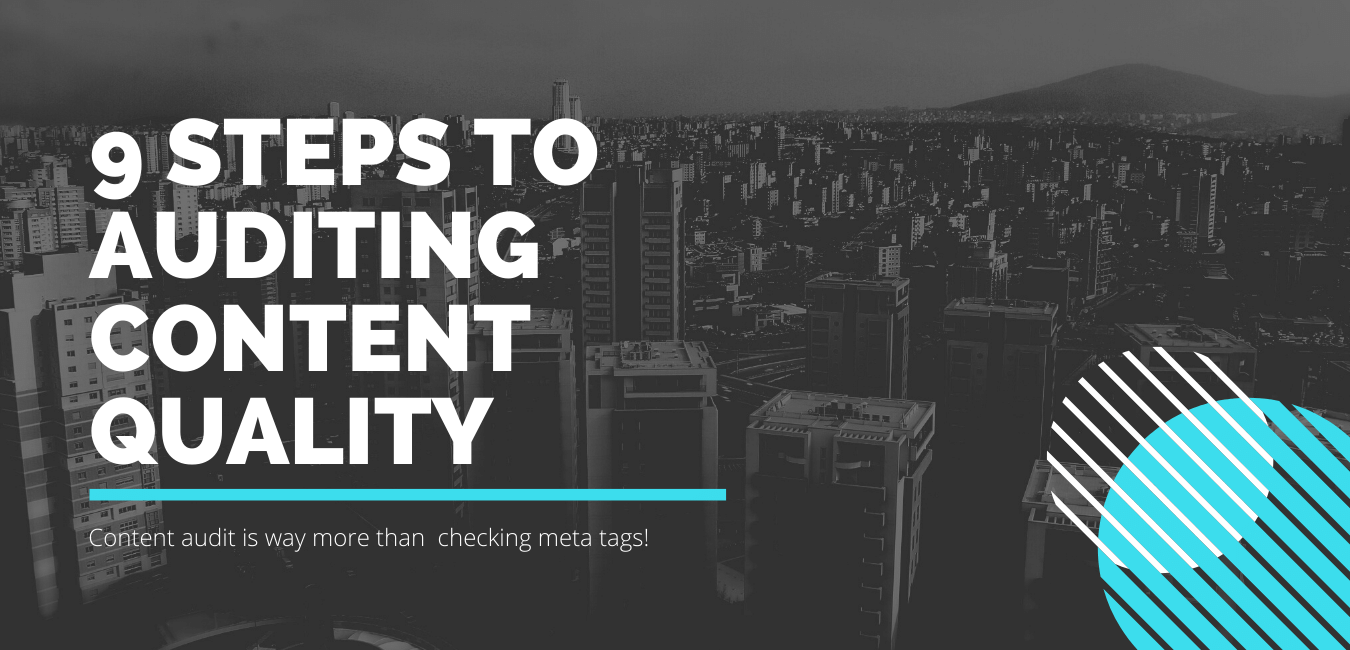By Dheeraj S | September 18th, 2020

If you are a professional Content Marketer for whom organic traffic on your own website is an important but not the only channel of acquisition, then it is likely that you already know why a content audit is not the same as an SEO audit. Yet, product vendors and even many experienced practitioners often refer to technical on-page audit tools and capabilities as a content audit. This is factually incorrect and reflects a very myopic view of content quality and the very purpose of doing an audit. This is especially true for companies looking to scale their content marketing programs and turn content marketing into a performance marketing technique.
In this article, we put forth our arguments as to why a comprehensive content audit is much more than just checking on-page tags, and broken links. The reason this distinction is important to understand is to ensure that you are equipped with the right tools and capabilities to scale content marketing efforts.
Why do a content audit?
Marketers can have multiple reasons for doing a content audit depending upon their maturity levels in content marketing and also the scale of their content marketing programs. There are three categories of Marketers.
Small sites and one-person content teams
Small sites are classed as ones that only rely on a single website and a single content format (e.g. blog posts) for acquiring traffic. The key objective of an audit here is to ensure higher traffic through better search rankings and they are almost always only interested in things like
- Ensuring that their pages are properly indexed in search engines (and hence checking things like meta tags, anchor text, etc.)
- Keyword portfolio optimization (identifying keywords for best search rankings)
- Quantity and sometimes even quality of backlinks that they get from other sites
The action lever (what you do with the audit results/recommendations) is usually limited to improving individual content items, discarding non-performing assets, and creating more content of the type that seems to get higher traffic. Content audit IS SEO audit here.
Mid-sized marketing departments
Next up come companies who may operate a network of sites that are interlinked (e.g. public site, resource library, gated content hubs, etc.) but still, deal with just one content format (most often HTML blog posts). The key difference from small teams, in this case, is
- A higher frequency and volume of content production
- Content is usually scattered across multiple owned properties
- Focused more on topic-based SEO as opposed to optimizing individual pages (simply because this takes a lot of time and resource)
- Attach greater importance to content metadata and classification in order to better understand the content profile and performance
As such, content audit here is not just about assessing on-page factors of individual pages but also about how the assets are interlinked and how content performs at the topic level (or some other higher level of aggregation). These companies typically also attach a lot more importance to assessing content engagement, assisted conversion metrics (content attribution), and not just inbound links.
The objectives of a mid-sized company in doing content audit could include one or more of the following-
- Identify technical on-page issues with individual pages on various sites.
- Identify keyword interlinking issues between content items within and across sites.
- Objectively assess content quality.
- Identify rankings, engagement, assisted conversions, etc. at arbitrary levels of aggregation (e.g. product, service, content topic, etc.)
The technology needed for doing automated content audits, in this case, is usually more complex than that used by small teams in that decisions have to be based on assessing content performance from across sites and not just at the individual page level.
This requires the ability to provide audit intelligence at arbitrary levels of aggregation and can become quite complex if you have to manually collate scan results from individual sites.
Large Enterprises and Businesses
Next up the ladder are enterprises with large-scale content marketing programs (e.g. large B2B companies) that produce content for multiple internal brands, customer segments, using different formats and multiple publication channels. Content audit here is not just about links, and engagement metrics but also about operational efficiency and assisted ROI. Some common insights that companies look to gain in this segment include
- How much content exists for each product/service?
- In what format? (and many other metadata points that companies devise in order to better understand content)
- On which channel?
- Asset re-repurposing factors
- Assessment of technical on-page factors (in case of published HTML)
- Time/cost of asset production for various asset types
- Identifying issues in content engagement and assisted conversions with reference to specific audience segments
- Tracking content to requisition requests and other procedural insights
These (and many more) are highly relevant insights that companies seek to glean from holistic content audits as they usually spend large proportions of marketing budgets on content marketing. Getting found on search engines is still a priority but of far more importance is the ability to do this at scale, and at optimum levels of cost-efficiency.
Summary-Strategic outlook but tactical execution
While it is certainly true that any audit should have clearly defined objectives based upon the individual business context, it is equally important to have a very clear picture of how SEO audit differs from the larger content audit.
Content audit-Key audit capabilities to implement
Now that there is (hopefully!) a better appreciation of what content audit entails at a conceptual level, the question is what specific features or capabilities to focus on as part of a wider content audit?
The answer lies in our post here. But for a summary, here is a list of top-level categories
- On-page technical checks
- Internal content interlinking across all sites and properties
- Keyword utilization
- External backlinks
- Content makeup and classifications
- Qualitative content assessment based on custom data points and criteria
- Content analytics (web analytics, search engine performance, social insights)
By letting your audit process/tool deliver insights around these data points will provide a solid data backbone for content planning.
- Content marketing ROI tracking
- Objective content scoring
As companies evolve their content marketing programs, they will need to adapt their tools, and processes used to produce and deliver content at scale. Tools that focus on delivering isolated site scans with a pure SEO focus are unlikely to be effectual as content marketing becomes more sophisticated.
Without knowing the road ahead when it comes to the potential outcomes of a content audit, it is highly likely that companies may end up doing something right but not necessarily the right thing!




